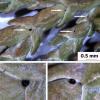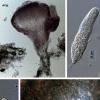
11-01-2026 20:35
Hello.A very tiny pyrenomycete sprouting sparsely

09-01-2026 17:41
Arnold BüschlenHallo, F. dilatata wird von vielen Bryoparasiten

10-01-2026 20:00
Tom SchrierHi all,We found picnidia on Protoparmeliopsis mur

07-01-2026 22:22
 Danny Newman
Danny Newman
Tatraea sp. on indet. hardwood The Swag, Great Sm

10-01-2026 01:18
 Danny Newman
Danny Newman
cf. Neovaginatispora fuckelii on indet. shrub Pre

07-01-2026 10:24
 Danny Newman
Danny Newman
Pezicula sp. on indet. hardwood Appalachian Highl

09-01-2026 10:08
 Blasco Rafael
Blasco Rafael
Hola, en el mismo habitat que la anteriorRetamaDia

08-01-2026 21:22
 Blasco Rafael
Blasco Rafael
Hola, He recogido esta muestra de Orbilia sobre Re

07-01-2026 17:29
 Marc Detollenaere
Marc Detollenaere
Dear Forum,On a barkless Populus I found some smal

10-11-2021 17:33
 Riet van Oosten
Riet van Oosten
Add-on topic http://www.ascofrance.com/forum/7059
This a tiny ascomycete developing just between green leaves of Chamaecyparis spp., which grew in a garden in eastern Spain. Its lifestyle seems to be saprotrophic so no harm symptoms have been observed where it grows. Abundant, but only on specimen per leaf flap.
The black-reddish ascomata are stipitate to pseudostipitate, with an overall slightly clavate shape, often bright, with a basal, hialine bundle of "rhizoids", and diameter ranging from 195 to 340 µm, and the height between 250-430 µm. I believe they are true apothecia, with an irregular disc shape, concave when young and slightly convex in mature individuals; in the later, the surface can be somewhat covered by dark pruina.
Exciple thin, 17-19 µm thick, deep brown to black with a reddish tinge; external layer gelatinized, made up of parallel and radially arranged, septate hyphae, 6-7 µm of diameter. Inner tissue of the stipe arranged as textura intricata.
Hymenium up to 150 µm thick. Hamathecium made up of hyaline, strongly branched-anastomosed ¿pseudoparaphyses?, with abundant granular content, 2-4'5 µm of diameter. They become more compact and gelatinized towards the epithecium and exciple. Asci deeply embedded into the hamathecium, first ellipsoidal and full of VBs, then becoming more fusiform when spores are mature, 8-spored, 75-85 x 16-21 µm. No reaction to I detected.
Spores two-celled, smooth, hyaline, 23-27'3 x 8-9 µm with one cell rather becoming more elongated and narrow.
Any suggestion will be welcomed!!
Regards,
Isaac

look at this one: http://www.landesmuseum.at/pdf_frei_remote/Sydowia_13_0064-0066.pdf
Does it match with Pseudodiscus?
Regards
Martin
Thanks for your suggestion!! It really seems to match to this species. Yesterday I could download the paper and make a fast reading, but I didn't save it; today I can't download it so I am not still able to confirm its identity. Anyway, I think this is a very interesting fungus with a peculiar ecology. Do you know if there are more recent papers where this species is referenced? Or has any collaborator of ascofrance ever found this species?
Thanks in advance!
Regards,
Isaac

I am not aware of any more recent paper on Pseudodiscus. If you can prove the identity, your documentation is possibly the first after Arx&Müller.
Regards
Martin

